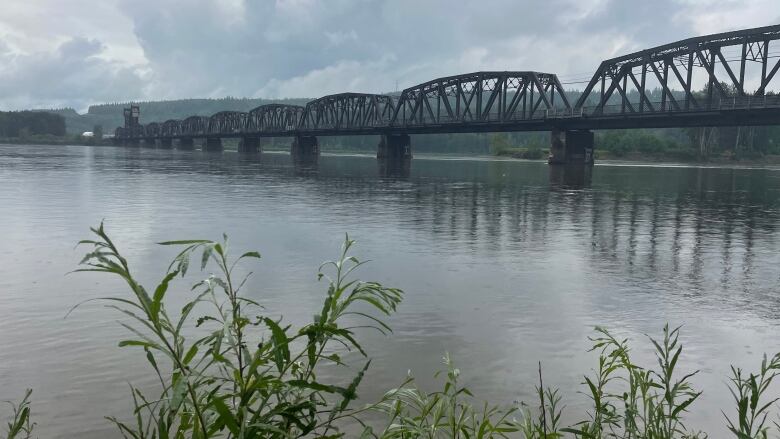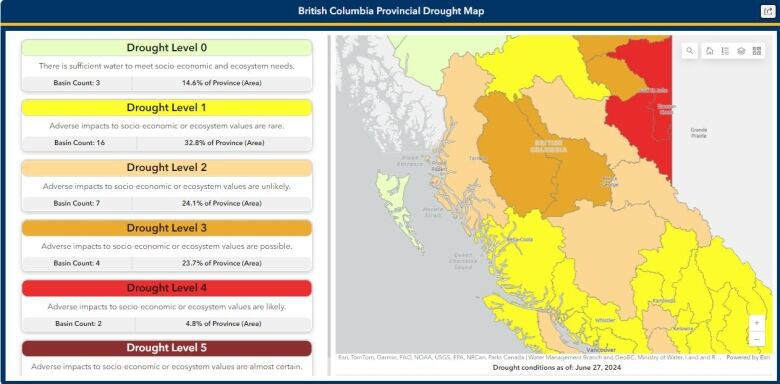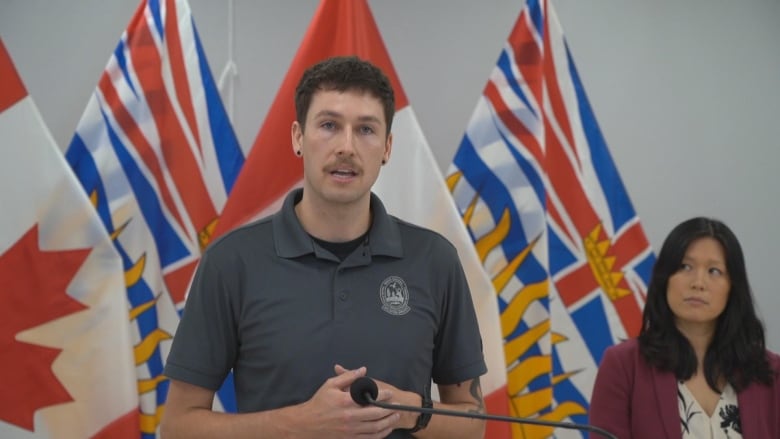Rain eases fire fears but drought continues in northeast B.C.
Lack of precipitation has been affecting farmers and power producers in Peace, Fort Nelson since 2022

A historic drought plaguing northeast B.C.for more than a year has been downgraded due to recent wet weather, but adverse impacts are still possible, forecasters have warned.
Drought in the northeast has been at or near Level 5 since the fall of 2022, affecting food and power production in the region, which also powers much of the province.
On Thursday, the B.C. River Forecast Centre updated its drought watch, downgrading the Fort Nelson and North Peace watersheds from drought Level 4 the second-highest level possible todrought Level 3.
The East Peace and South Peace regions, which include Fort St. John and Dawson Creek, meanwhile, are at drought Level 4. That is a downgrade for the East Peace, which has been at drought Level 5, the highest possible, since November 2023. The South Peace has been at Level 4 since record-keeping resumed in May, after also being atLevel 5 in the fall of 2023.
CBC science communicator Darius Mahdavi said while the downgrade is some "much needed good news," it is important to remember that a Level 3 drought still indicates serious conditions.
The B.C. government classifies a Level 3 drought as one where "adverse impacts to socio-economic or ecosystem values are possible," while a Level 4 is one where adverse conditions are "likely" while at Level 5, they are "almost certain."
"I don't want to put a damper on things, but ... as we saw this time last year, a couple hot, dry weeks is all it takes to send us right back into exceptional drought," he wrote.

Still, he said,provincewide, "we're in a much better spot than we were a year ago."
Ongoing drought has had a particular effect on agricultural and energy production in the province's north. Roughly 80 per cent of B.C. grain production occurs in the Peace, according to provincial figures, while oil and gas operations in the area are also highly reliant on water for fracking and other aspects of production.
It's also affected energy production and dams in the region, forcing B.C. Hydro to import power from other jurisdictions.
The ongoing dryness has also posed a challenge to wildfire fighters, with multiple blazes that started in 2023 resurfacing this spring and posing a threat to nearby communities as well as creating conditions ripe for new fires to take hold.
That was particularly evident in Fort Nelson earlier this year when a downed tree hit a wire and forced more than 4,500 residents to evacuate for more than two weeks.
Mayor 'still nervous' after Fort Nelson evacuations
In an interview with the Canadian Press, Mayor Rob Frasersaidthe community is feeling more comfortable after a week of wet weather and a downgraded drought threat, but that doesn't mean they're blind to the risk of wildfires that still exist in the region.
"We're still nervous. If you look at the fire maps, you can see that the whole northeast corner up here is just one big red blob. So there's lots of fire on the landscape," Fraser said. "Still makes us nervous.
"But the fact that the drought level is coming down, we're getting some rain, is making everybody feel a little bit more comfortable."
Fraser says plumes of smoke are still visible on hot days, and residents know that a stretch of hot, dry weather would be enough to increase fire behaviour again.
The mayor says the hot spots are burning "in the black," meaning they are within the charred boundaries of previous firesand not spreading.
Fraser says the community is going ahead with Canada Day festivities this weekend, and tourists have been returning since the evacuation ended.
"I think those people, they just held off and now they're coming. We see our campsite full, we're seeing people walking around town;the museum is full of people," he said.
"So we're pretty optimistic as we look over our shoulders at where these fires are burning."
Province urges caution ahead of Canada Day long weekend
Thursday's numbers from the B.C. Wildfire Service show that 79 of the 91 active wildfires in British Columbia are burning in the province's northern region, known as the Prince George Fire Centre, including five that have started in the last 24 hours.
B.C. Wildfire spokesman Forrest Tower told reporters Thursday that the southern part of the fire centre, which includes Prince George, has received "pretty significant precipitation," while the same cannot be said for the northern portion including Fort Nelson.

"Looking into the next several weeks, probably going into the month, it looks like it's going to continue to be hot and dry. So a large amount of our resources right now are up in the Fort Nelson/Fort St. John area," he said.
"We likely will still see some pretty challenging fire behaviour and conditions, especially in the northeast ofB.C. But just this bit of window where we aren't seeing fire everywhere else, that really allows us to put a large amount of our resources on those pretty significant fires in the northeast ofB.C."
Minister of Emergency Management Bowinn Ma told the news conference that it's fortunate that resources are able to be directed to the north.
"But let me be clear, even though we have seen a significant amount of precipitation over the last several months, snowpack levels are still very low," she said.
"And when those rains cease, we are still at risk of severe drought in many parts of the province."
The government is asking residents and visitors to be prepared for potential wildfires this long weekend and check for road closures, alerts, evacuation orders and other prohibitions before travelling.
With files from the Canadian Press














_(720p).jpg)


 OFFICIAL HD MUSIC VIDEO.jpg)
.jpg)



























































































